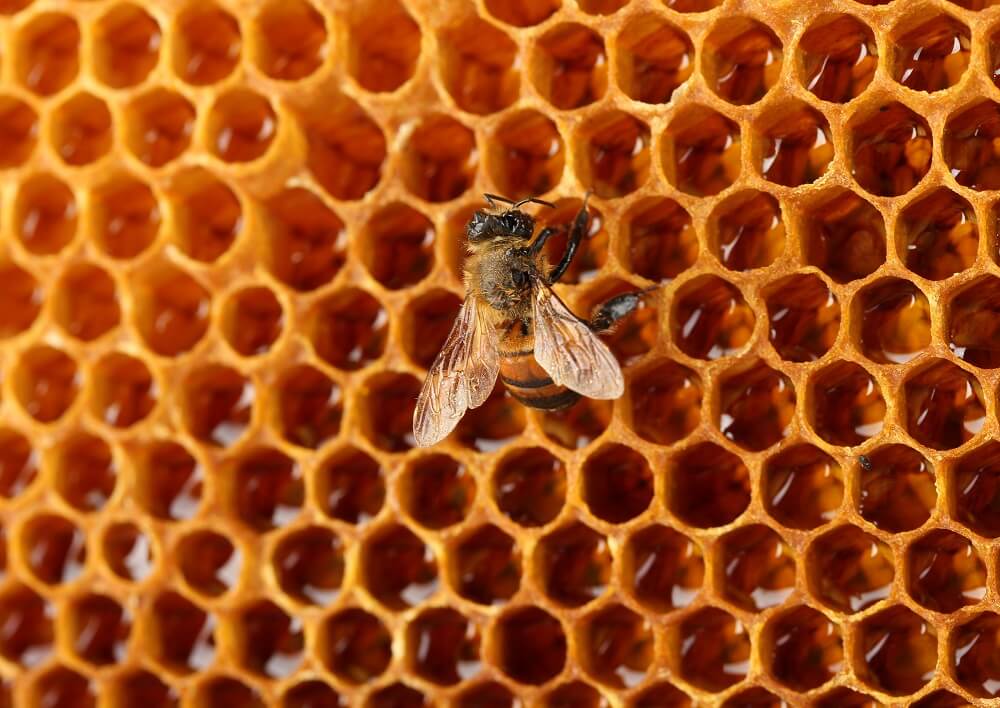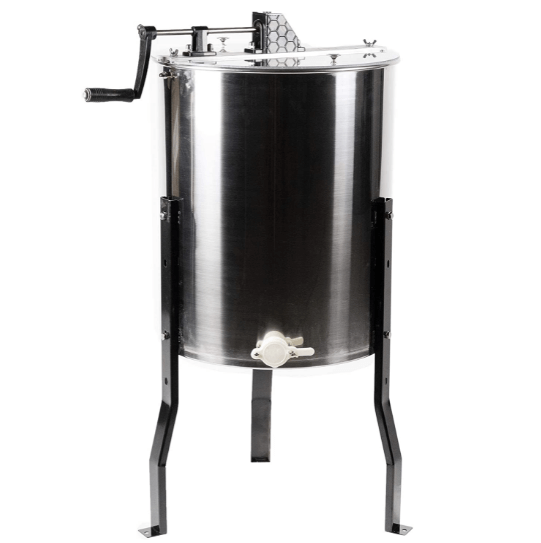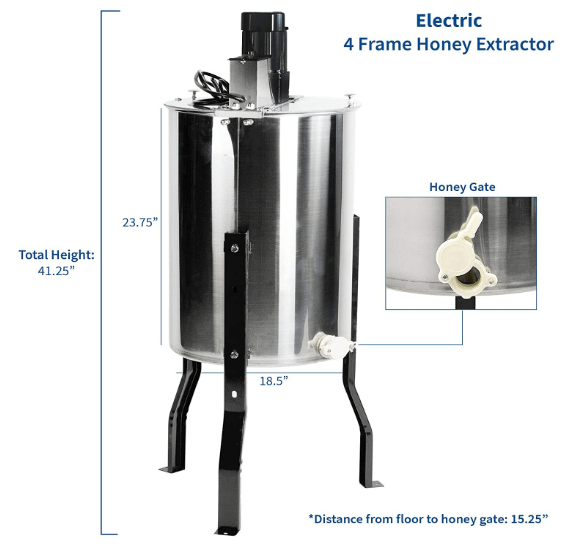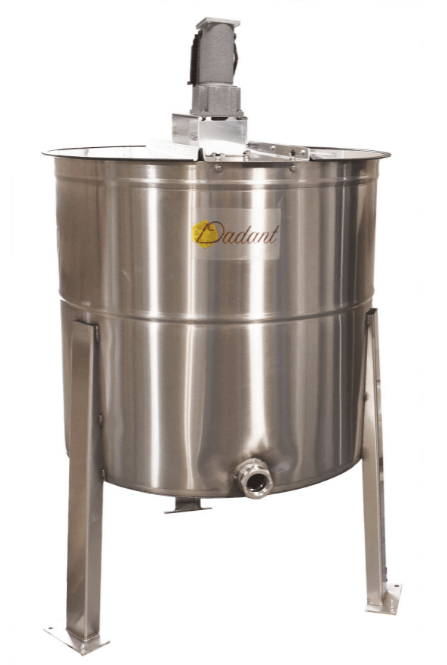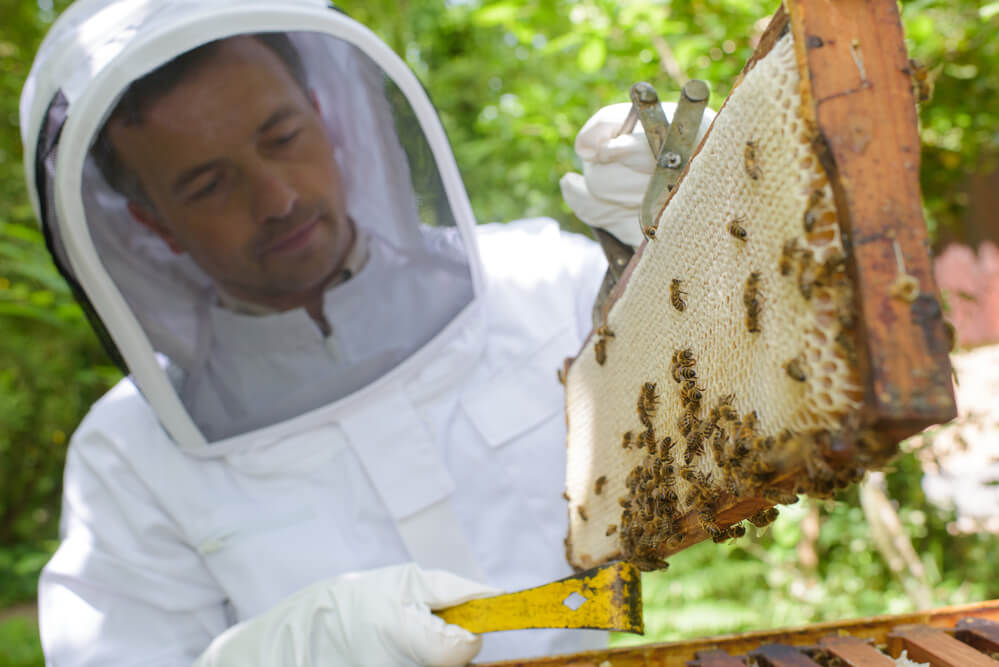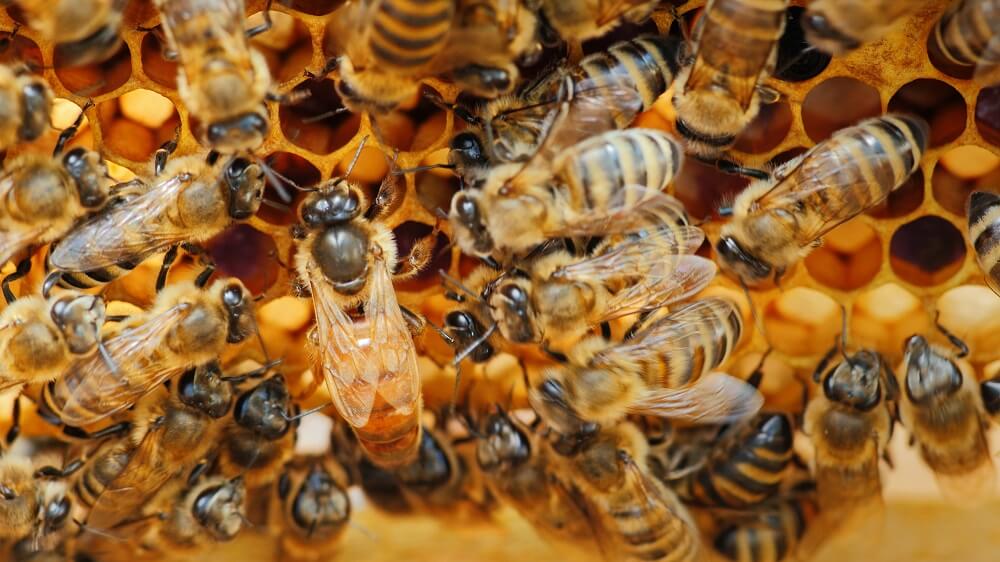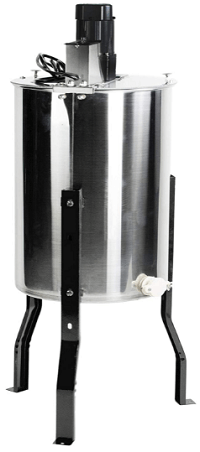In this article:
The 3 Best Honey Extractors on the Market:
1. Best Honey Extractor for 1-10 Hives: Manual Honey Extractor
This manual extractor is perfect for the backyard beekeeper who wants to save time and money. It can hold up to four deep, medium, or small frames at once. This makes it twice as fast as the other extractors that only hold two frames. Overall, you get more for your money with this one. It’s high-quality stainless steel and will last you a long time.
2. Best Honey Extractor for 10-50 Hives: Electric Honey Extractor
If you’re serious about beekeeping, this electric extractor is for you. It can hold up to four deep frames or eight small/medium frames at once. No manual hand cranking is necessary, which will save your arms from getting exhausted. You just load your frames and let this extractor do the work for you. Finally, this extractor is stainless steel which makes it rust-resistant and durable.
3. Best Honey Extractor for 50+ Hives: Commercial Honey Extractor
This electric honey extractor is meant for a large operation since it can hold 20 frames at a time. It’s a radial unit, which means it spins the honey from both sides of the frame. So you can skip manually turning your frames to get honey from both sides. It’s the fastest and easiest way to extract honey for commercial operations.
1. Best Honey Extractor for 1-10 Hives: Manual Honey Extractor
This is a sturdy honey extractor that can hold up to 4 deep frames or 8 small/medium frames at once. Since it can hold four frames instead of two, it makes extraction much faster.
That said, this is a manual extractor instead of an electric one. This means it has a hand crank that you use to spin the frames yourself.
Here’s an example of the hand crank:

Manual extractors are perfect for backyard beekeepers who don’t have too many frames to harvest.
It’s easy to put together, and ships fast. The stainless steel drum makes it rust-resistant and easy to clean.
It also comes with a clear lid that allows you to peek inside and monitor your honey extraction.
Overall, Vivo’s honey extractor is a great value for backyard beekeeping on a budget.
The only con would be that you might grow tired of using a manual extractor in the long-run.
My suggestion?
Buying an electric extractor is a smart move for beekeepers who plan to add more hives to their apiary.
Because keep in mind:
You want a honey extractor that’ll suit your beekeeping needs for at least three years or more.
So, for example:
If you plan on having ten or more hives within the next three years, then it’s worth buying an electric extractor like this one.
If you plan on maintaining a small number of hives, then Vivo’s manual extractor (above) will suffice.
What makes this the best honey extractor:
- Great value because it can spin up to four deep frames or eight small/medium frames at once
- Easy to assemble
- Made of stainless steel, so it’s rust-resistant
2. Best Honey Extractor for 10-50 Hives: Electric Honey Extractor
This honey extractor is electric, which makes it a huge time saver. (If you’ve only ever used manual extractors before, this one will make a world of difference.)
And in case you’re wondering:
The difference between electric and manual is simple.
Electric honey extractors just require you to load your frames and press a button. Then the honey starts extracting.
Manual honey extractors require you to hand crank the machine to extract the honey.
Both electric and manual will do the trick, but electric extractors make your life easier if you have several hives. They’ll save your arms and back from getting exhausted.
Trust me. You’ll thank me later.
This honey extractor can hold up to four large frames or up to eight small or medium frames.
It has a built-in cooling fan that prevents the extractor from overheating. It’s also easy to track the progress of your honey extraction because of the clear lid. You can peek inside easily.
It also has a speed dial that gives you control of how fast it spins:

A built-in safety feature turns the extractor off whenever the lid is opened. Then it automatically resumes once the lid is closed again.
Vivo’s honey extractor ships fast and arrives in good packaging to prevent dings.
It’s a sturdy extractor with all stainless steel hardware.
Lastly?
If you take care of this honey extractor, it can last you several years. You’ll be able to harvest hundreds or thousands of pounds of honey from it.
What makes this the best honey extractor:
- It makes honey extraction quick and simple
- Easy to assemble
- Can hold up to 4 large frames or 8 small/medium frames at once
- Made of stainless steel, so it’s durable and resists rusting
- Great value
3. Best Honey Extractor for 50+ Hives: Commercial Honey Extractor
If you have a large operation, you’ll need a honey extractor like this one. It holds 20 frames at once with a 30″ diameter.
It’s a radial extractor which means it removes honey from both sides of the honeycomb at once. This is the quickest and most efficient way to extract honey.
What makes this the best honey extractor:
- High-quality and will last you years
- Made in the USA
- Can hold 20 frames at once
- It makes honey extraction faster and easier for commercial beekeepers
What is a Honey Extractor, Anyway?
A honey extractor collects honey from bees without damaging their honeycombs. Once finished with the extraction, the honeycomb can be returned to the hive for the bees to refill.
Here’s an example of what a honey extractor looks like:
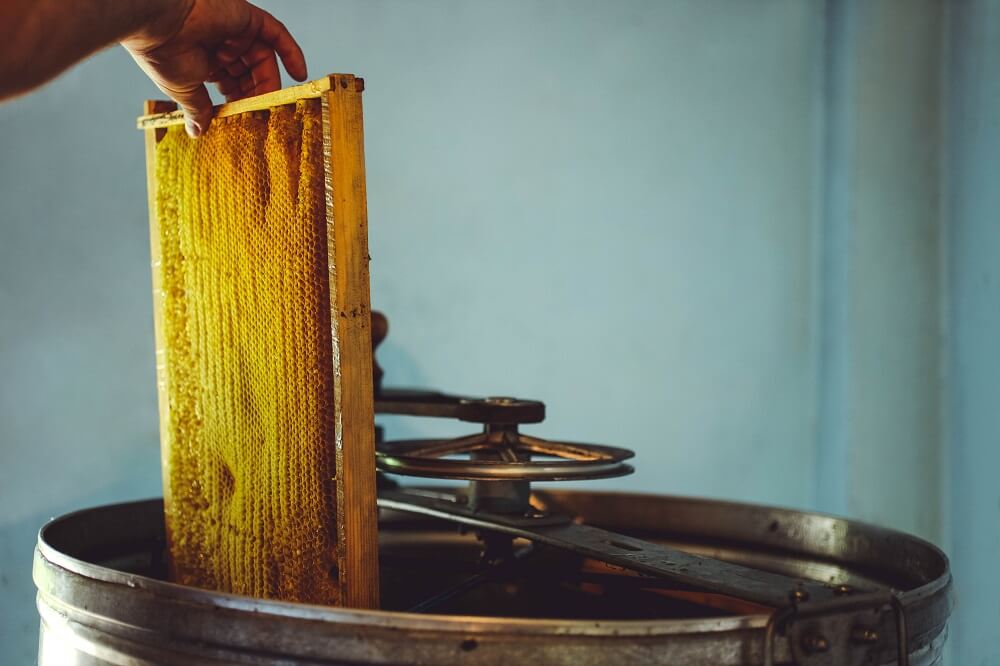
Now you might be asking:
How does a honey extractor collect the honey, exactly?
Simple.
A honey extractor “flicks” the honey from the comb by spinning the frames. From there, the honey drizzles down into the bottom of the extractor, where it can be poured out from the nozzle.
Check it out:
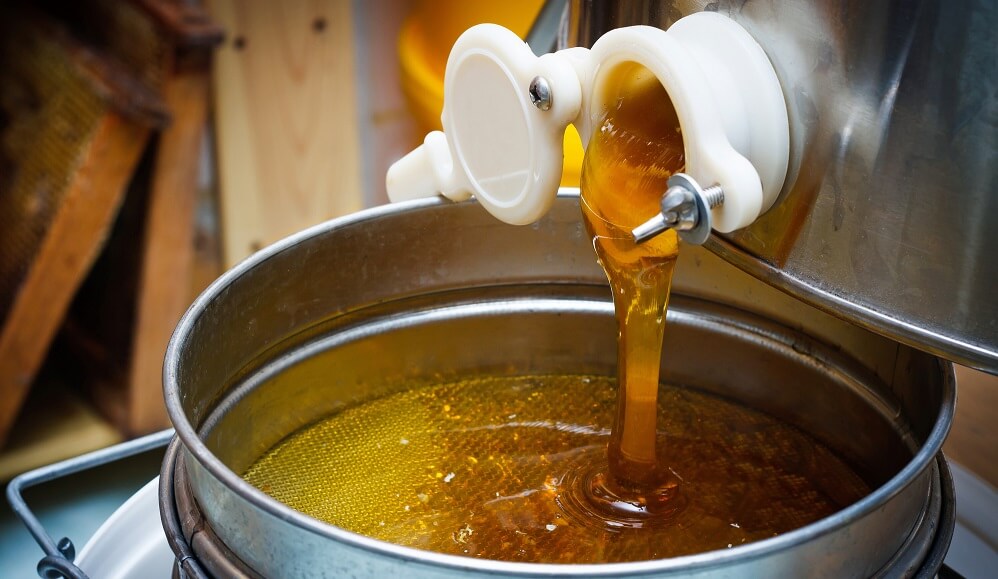
You can extract honey without an extractor, which is ideal for people dipping their toes into beekeeping.
Also, if you’re a part of a beekeeping community, you can save money by borrowing an extractor.
Because as you know, between buying your bee suit and other equipment, things can add up fast.
So with those things in mind, the question becomes:
Why buy a honey extractor?
Good question.
Honey extractors make your life easier. You can collect your honey quickly and easily without the hassle of making a mess. As a result, you’ll enjoy your beekeeping hobby more because of it.
More importantly?
If you use a honey extractor, you can return the honeycomb to your bees once you’re finished.
Plus, owning a honey extractor instead of borrowing one means you don’t have to plan your honey extraction around everyone else’s schedules.
Fast Facts About Honey Extractors:
- Who should use them: Beekeepers who want to save time and labor. Also, beekeepers with more than five hives.
- Who can skip them: New beekeepers and/or beekeepers on a budget. In this case, extracting your honey without an extractor is perfectly fine.
- Main benefits: They make honey extraction quicker and easier. They also let you return the honeycombs to your hive, thus preserving the bees’ hard work.
How Do I Choose the Best Honey Extractor for My Needs?

Let’s back up a bit.
Before asking, “What is the best type of honey extractor?” you should first ask yourself:
How many hives do I want to have two or three years from now?
This ensures you’ll get the biggest bang for your buck because your extractor will meet your needs now and in the future.
Once you answer that question, then you should follow these three steps:
Step 1: Pick the Right Size Honey Extractor
“What size honey extractor do I need?” is a popular question amongst beekeepers.
To make things simple, I’ve broken this down into three categories:
- Best honey extractor for 1 – 10 hives: You’ll need a manual honey extractor with a capacity of 3 or 4 frames. That said, if you want to save yourself even more time and labor, pick an electric instead of a manual.
- Best honey extractor for 10 – 50 hives: You’ll need an electric honey extractor that can hold 4 deep frames at once.
- Best honey extractor for 50+ hives: You’ll need an electric radial honey extract that holds 20 frames or more.
Step 2: Decide Between Manual or Electric
Remember, you should be asking yourself:
How many hives do I want to have two or three years from now?
Thinking ahead will save you money in the long run because you’re more likely to buy the right extractor.
That said, let’s briefly discuss the difference between manual and electric extractors.
Manual extractors are commonly used by beekeepers with one to ten hives. They have a hand crank on the side to spin the frames.
For example:
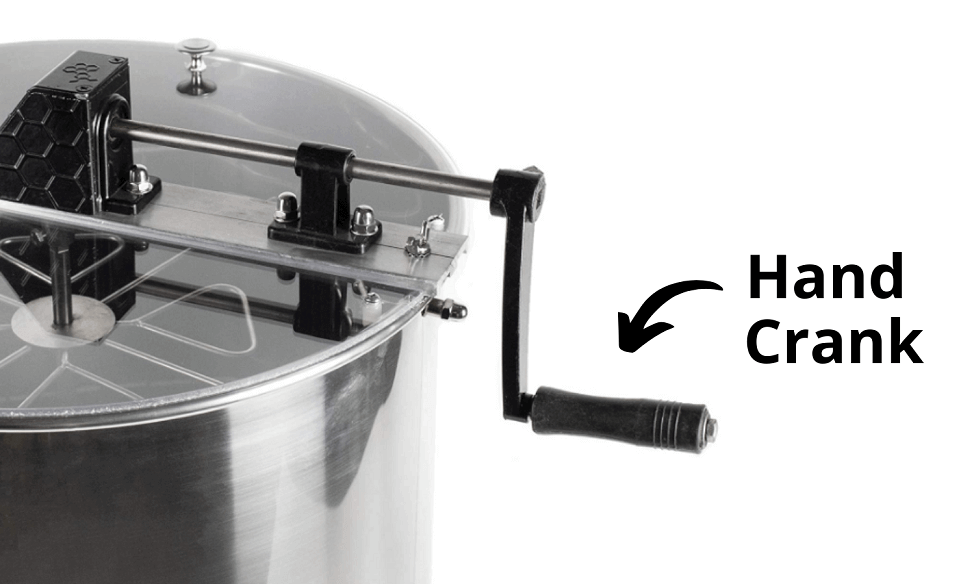
Manual extractors require some elbow grease. But, they’re cheaper than electric extractors. Because they’re hand-cranked, they do require more time and labor.
Electric extractors are commonly used by beekeepers with more than ten hives. They’re also used by beekeepers with limited physical strength and/or beekeepers who prioritize saving time and energy.
Electric extractors are motorized, so you just need to turn them on and allow them to do the work for you. They allow you to harvest large amounts of honey with minimal effort quickly.
Step 3: Choose Either Tangential or Radial
The main difference between tangential and radial extractors is the frame orientation. In a nutshell, the frames are positioned differently inside the extractor.
Tangential extractors spin the honey out of the frames one side at a time. After you’ve finished collecting honey from the first side, then you’ll stop the extractor and turn the frame around. This allows you to spin the honey out from the other side.
Backyard beekeepers commonly use tangential extractors.
Radial extractors remove honey from both sides of the honeycomb at once. These extractors are the quickest and easiest way to extract honey from the comb.
Radial extractors are commonly used by commercial beekeepers with more than 50 hives.
FAQs about the Best Honey Extractors:
- Is a honey extractor worth it?
- Can I extract honey without a honey extractor?
- Is a manual or electric honey extractor better?
- How long does honey extraction take?
- How fast does a honey extractor spin?
- Why do you spin honey?
- How do you stabilize a honey extractor?
- What is a radial honey extractor?
- How much honey do you get from a hive?
- How many times do you harvest honey in a year?
- Should I harvest honey the first year?
- What time of day is best to harvest honey?
- What’s the best way to clean a honey extractor?
- Can I eat raw honey straight from the honey extractor?
- How do I make my own honey extractor?
- How long do honey extractors last?
- Do I need any accessories with a honey extractor?
Is a honey extractor worth it?

It depends.
If you’re a new beekeeper, a honey extractor can wait. You should put off big expenses until you have more experience. Then, you’ll know more about what kind of extractor you want and what your bank account will support.
Here’s the thing:
Soon-to-be beekeepers sometimes order a honey extractor along with their first hive. This is unnecessary because to have a honey extractor, you need to have honey first.
Plus, you shouldn’t try to collect honey during your first year. Your new colony needs time to get established, and they need every drop of their honey to survive the winter.
Secondly, if you join a beekeeping community, you can borrow a honey extractor from them or rent one.
In my area, you can rent a honey extractor for $20. Not only is that more affordable for new beekeepers, but it saves you from having to use storage space.
That said, I know some beekeepers disagree with me on this.
Why?
Because the only part of beekeeping that really sucks is honey extraction. It’s one of the hardest parts of the entire process.
That’s why many beekeepers recommend getting a honey extractor – even if just a small one – to make it easier on yourself.
It’s also why many beekeepers are turning to flow hives because they allow you to pour honey straight from the hive without a honey extractor.
My opinion?
Try extracting the honey without a honey extractor first. From there, you can decide if buying a honey extractor is worth it and if it truly saves you time and money.
—> Go back to the FAQs about the best honey extractors
Can I extract honey without a honey extractor?
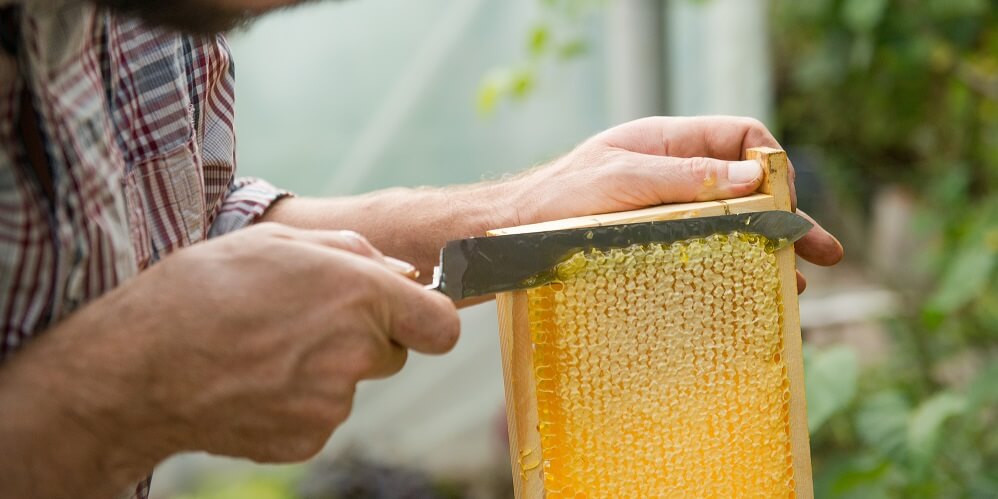
Yes.
As a new beekeeper, you can skip the honey extractor and try one of the following methods:
1. The Cut Comb Method
This method involves cutting the honeycomb into pieces and letting the honey drain out of it.
You’ll need:
- A sharp knife
- A baker’s cooling rack
- A baking sheet
Start by placing the cooling rack on top of a baking sheet.
Next, begin cutting the comb into squares and placing it on top of the cooling rack.
Three or four inch honeycomb squares are common, but you can do any size you like.
Here’s a helpful tip:
Wipe your knife after each cut to keep the honeycomb clean.
Once you’re done cutting, allow your honey to drain on top of the cooling rack into the baking sheet for several hours. Then you can collect the honey in the baking sheet and pour it into the containers of your choice.
Keep in mind that you can only do this method if you don’t use plastic foundations. That’s why I recommend using wax foundation in honey supers. Or going foundationless and allowing the bees to build their own.
2. The Crush and Strain Method
This method involves crushing the honeycomb until there are no lumps then straining it, so it filters out the comb.
You’ll need:
- Two large bowls
- A potato masher or wooden spoon
- A honey strainer, cheesecloth, or a paint strainer
Start by cutting the honeycomb from the frame and putting it in a bowl. If you’re using a plastic foundation, scrape the honeycomb from each side and place it in the bowl.
Next, grab your potato masher or wooden spoon and begin crushing the comb.
Now don’t get me wrong:
Crushing the honeycomb isn’t fun because you’re essentially destroying your bees’ hard work. But, you have to crush every cell to get honey, so keep doing so until there are no lumps.
Then you’ll strain your honey through a honey strainer, a cheesecloth, or a paint strainer.
You’ll need to let it sit overnight to extract all the honey.
Bonus tip:
If you allow it to strain in a warm place, the honey will drain faster. That said, you don’t want it to be too hot because it can melt the comb.
3. The Combination Method
We’ve talked about comb honey and strained honey, but you can have a mixture of both.
This means you’ll have a jar of honey with a honeycomb sitting at the bottom. You’ll see this commonly in gift shops or small mom-and-pop stores that sell honey.
The process is simple.
Start by cutting a piece of your honeycomb and putting it into a jar. Then, pour strained honey on top to fill the rest of the jar.
And there you have it.
—> Go back to the FAQs about the best honey extractors
Is a manual or electric honey extractor better?
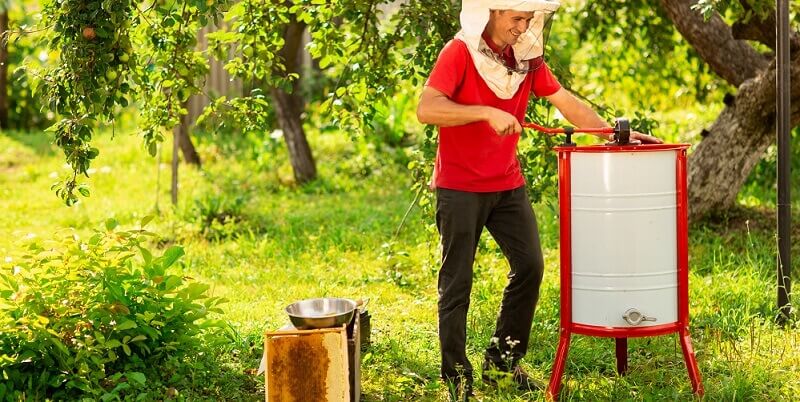
“How do I choose a honey extractor?” is a common question we get.
The truth is, both manual and electric extractors have their pros and cons.
Manual honey extractors are best for small beekeepers who are on a budget. You can get an affordable one for $150 – $200.
Manual extractors come with a hand crank you have to spin yourself to extract the honey. Despite this, manual extractors will still save you time over just straining the honey yourself.
Vivo’s manual extractor is one of the best honey extractors for beginners.
Plus, cleanup is easier with an extractor than it is if you’re extracting the honey in your kitchen.
The big con with manual extractors is the hand crank. Your arms and back can quickly get exhausted. This is why I don’t recommend manual extractors for people with many hives or limited physical strength.
So what about electric extractors?
Their biggest pro is that they do the hard work for you. You just load your frames into the extractor and turn the unit on. It’ll spin itself, and you can control the speed via a speed dial.
If you have a lot of frames and want to save yourself a lot of labor, this is the way to go.
The con with electric extractors is the cost. You’re looking at about $300-$500.
But don’t forget:
Before you buy an extractor, you need to think about where you’re going to be in three or four years.
What do I mean by that?
You should ask yourself how many hives you plan on having in the future. Then, you can buy an extractor that not only makes sense for you now but will in the future as well.
This is how you get the biggest bang for your buck.
Also, most extractors are made of stainless steel. So if you clean and maintain them, they can last you for years to come.
Sure, you may have to fork over the cost upfront, but the honey extractor will pay for itself if you keep it in good condition.
Related: How Many Bees are in a Hive?
—> Go back to the FAQs about the best honey extractors
How long does honey extraction take? How long does it take to extract honey with a manual extractor?
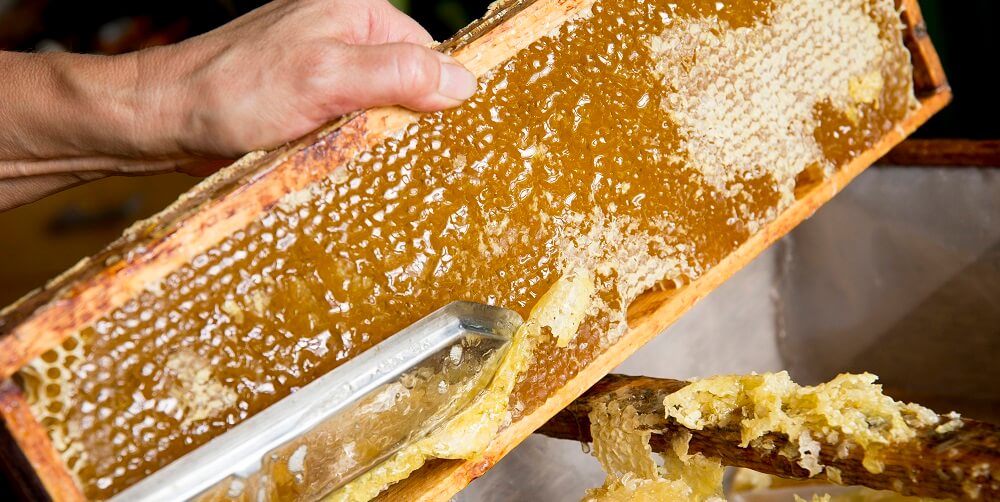
It depends.
I know, I know.
You’re probably tired of hearing me say that. But, it truly does depend.
Most beekeepers set aside a few days for honey extraction. Of course, if you’re a new beekeeper with only 20 pounds of honey to harvest, it won’t take a few days.
But here’s the deal:
Most frames will need to spin 5 to 10 minutes in your honey extractor.
The faster the spin, the faster the honey will be extracted. However, you don’t want to spin your frames too fast because it can damage the comb.
If you’re extracting honey without an extractor, you’ll need to let the honey strain overnight. Depending on how much honey you have, this can take several days. Also, the warmer the place, the faster the honey strains.
But keep in mind:
You don’t want it to be too hot of an environment that it melts the honeycomb.
So what’s the bottom line?
It’s hard to answer how long your honey extraction will take. It depends on several factors, including how many hives you have and the extraction method you’re using.
—> Go back to the FAQs about the best honey extractors
How fast does a honey extractor spin?
The average electric extractor can reach up to 300 and 360 RPM speeds.
The important thing to remember is that sometimes the comb can be damaged if you spin too fast. This is especially true for foundationless frames.
You will have to experiment until you find what works best for you.
For manual extractors, the speed depends on how fast you crank the unit. This means it’s hard to give you an exact RPM for manual extractors.
—> Go back to the FAQs about the best honey extractors
Why do you spin honey?
Spinning the honeycomb flicks the honey out from the individual cells. Then it drizzles down into the extractor’s bottom to where you can pour it out of the nozzle.
—> Go back to the FAQs about the best honey extractors
How do you stabilize a honey extractor?
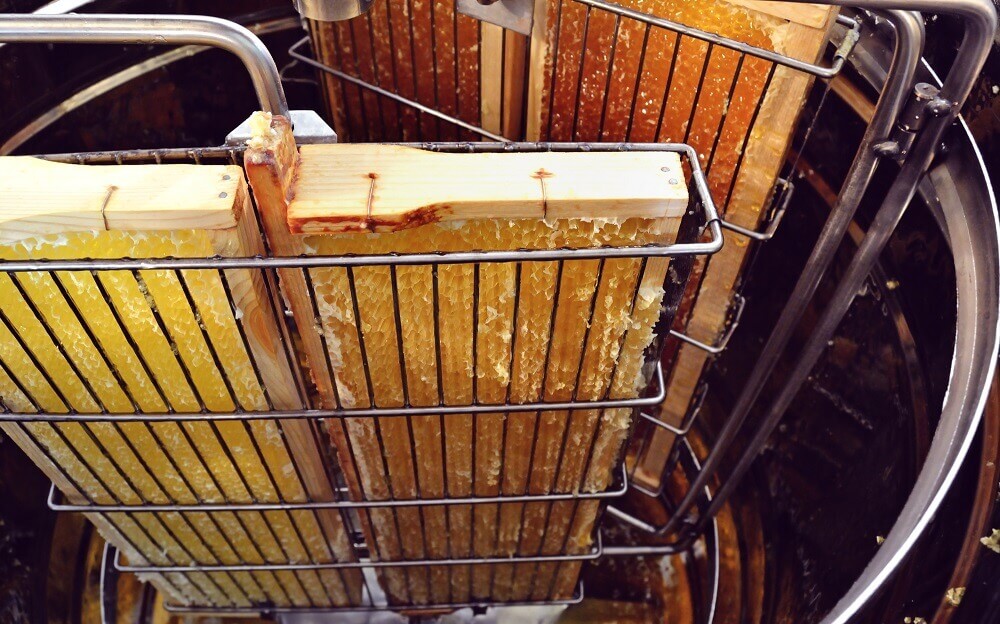
There are two main ways to do this, and you may have to experiment to find which one works best for you.
Option 1: Bolt the legs to plywood
Get a 1-inch piece of plywood that’s large enough to fit under your extractor legs.
Drill three bolts through the underside, then set your extractors leg holes over the bolts. Tighten this with wing nuts for quick and easy removal.
This gives you a large surface area for more stability.
And if you need more stability, you can add weights or sandbags under your extractor.
Option 2: Remove the legs from your extractor
When your extractor has legs, it’ll be fighting the turning force. The most stable honey extractors I’ve found don’t have legs.
Try taking the legs off and mounting your extractor directly to a solid base. A sturdy wooden platform works well as a base. Just make sure it’s high enough off the floor for a bucket to fit under.
Related: What Does a Queen Bee Look Like?
—> Go back to the FAQs about the best honey extractors
What is a radial honey extractor?
Remember:
There are two types of honey extractors: tangential and radial.
You have to flip your frames with tangential extractors to get honey out of both sides. So you’ll spin one side for a few minutes, flip it, then spin it again on the other side.
Radial extractors spin honey out of both sides at the same time. There’s no reason to stop and flip the frames.
Tangential extractors are more common because they’re more affordable and easier to find. Once you get the hang of them, they’re simple to use.
Radial extractors make the process quicker, but you’ll pay for that extra convenience.
All in all, there is no right or wrong choice. It just depends on your needs and budget.
—> Go back to the FAQs about the best honey extractors
How much honey do you get from a hive?
The average hive produces anywhere from 30 to 60 pounds per year.
This average doesn’t include new or weak hives. New colonies won’t produce nearly as much honey because it takes them time to grow their population and become established. This is why you should never plan to harvest honey in your first year.
On the other hand, strong hives can produce between 80 to 100 pounds of honey. This is using a traditional 10 frame deep box.
A medium box is likely to produce 40 to 60 pounds of honey since it’s smaller.
But keep in mind:
Honey flow is dependent upon several conditions, including:
- Weather
- Food and water supply
- Temperature
The most important thing to remember is that you should leave your bees with enough honey to survive winter. It also helps to make sugar water for bees in the early spring and fall, when nectar sources are scarce.
—> Go back to the FAQs about the best honey extractors
More to Explore:
How many times do you harvest honey in a year?
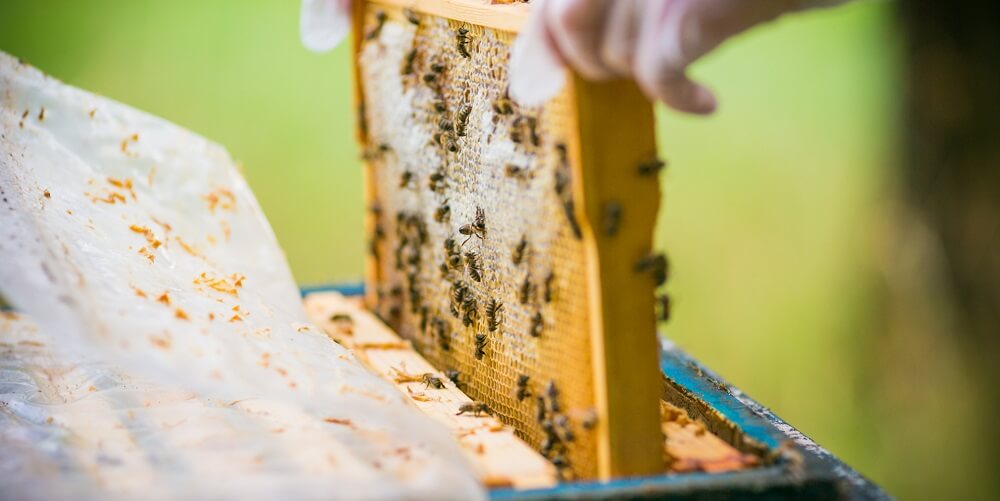
Most beekeepers harvest honey two or three times per year. Honey harvesting typically occurs between June and September.
But this also depends on your local climate. For example, beekeepers can only harvest once per year in the late summer or early fall in some climates.
Either way, you don’t harvest too early because you won’t get the full amount of honey available.
You also don’t want to harvest too late because you risk running into cold weather. That’s not good for your bees.
Also, if you don’t leave your colony with enough honey for the winter, they won’t survive.
—> Go back to the FAQs about the best honey extractors
Should I harvest honey the first year?
No.
The general rule of thumb is to not take honey from a colony in its first year. This is because your bees need time to get established and make enough honey to survive the winter.
And in case you didn’t know, bees need to eat their honey during the winter to keep them alive.
To help a new or weak hive get established, you should make sugar water for bees to provide them with food. Also, try planting the best flowers for bees in your garden.
And finally?
Have a few bee waterers that give your colony access to safe water. The emphasis is on safe because bees can’t swim, so they’ll drown if you don’t take the right steps.
—> Go back to the FAQs about the best honey extractors
What time of day is best to harvest honey?
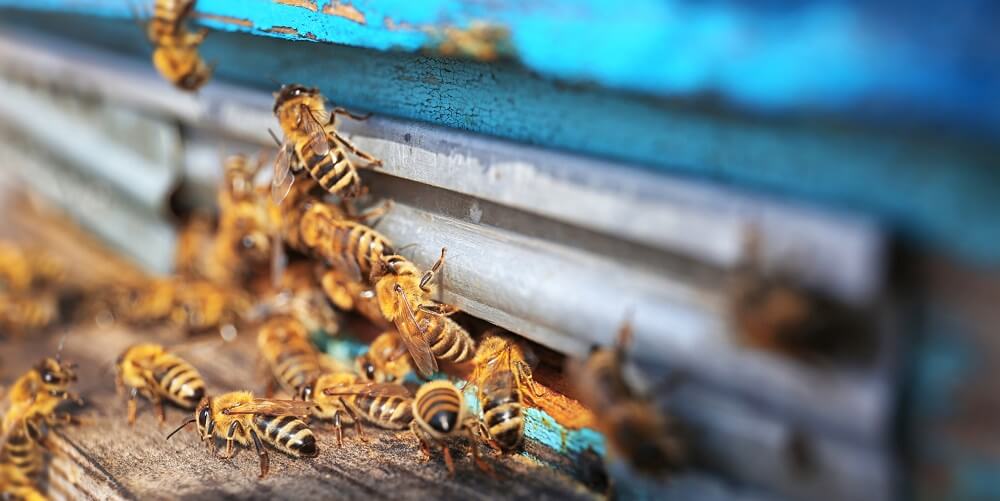
First, it’s important to give yourself at least half an hour per hive to remove the supers.
With that in mind, the best time to harvest honey is between 11 AM and 3 PM. This is because the worker bees will be out foraging for food, so you’ll have fewer bees to contend with.
And just as important?
Pick a sunny and warm day to harvest your honey. Don’t try to harvest your honey when it’s wet, windy, or cloudy outside. Honeybees become agitated in bad weather, so it’s best to avoid it altogether.
—> Go back to the FAQs about the best honey extractors
More to Explore:
What’s the best way to clean a honey extractor?
The best method is to use cold water from a hose. Don’t use hot water because it makes the wax soft and sticky, making it much harder to remove from the components.
Cold water makes the wax cold and brittle, so it’s easier to remove.
Some people suggest putting your extractor outside where the bees can clean it themselves.
The only problem?
This can cause a feeding frenzy and spread diseases amongst colonies. As a result, you’ll end up with a huge amount of chaos.
—> Go back to the FAQs about the best honey extractors
More to Explore:
Can I eat raw honey straight from the honey extractor?
Yes.
But if you’re going to be packaging your honey for sale, make sure you’re sanitary and avoid double-dipping.
—> Go back to the FAQs about the best honey extractors
More to Explore:
How do I make my own honey extractor?
Here’s a good quality video demonstrating how to make your own honey extractor:
The good thing about making your own honey extractor is that you can make it big enough to fit the frames from certain horizontal hives that traditional extractors can’t fit.
—> Go back to the FAQs about the best honey extractors
How long do honey extractors last?
Many extractors are made of stainless steel, so they’re durable and rust-resistant. If you take care of them, they can last you several years.
—> Go back to the FAQs about the best honey extractors
More to Explore:
Do I need any accessories with a honey extractor?
You’ll need all your regular beekeeping equipment when gathering your frames. This includes your bee suit, bee smoker, and hive tools.
Then, once you’ve gathered your frames, you’ll need:
- An uncapping knife so you can open the honeycomb cells and extract the honey.
- Bucket(s) so you can drain the honey out of the extractor into the buckets. I recommend 3.5-gallon buckets because they aren’t as heavy as 5-gallon buckets.
- Bucket filters to help remove any random bits of beeswax that are left in the honey.
